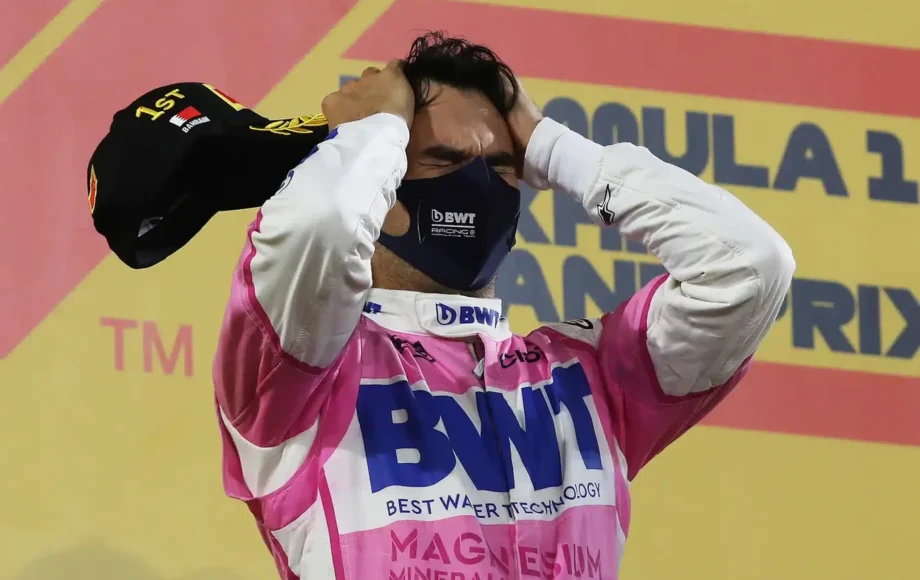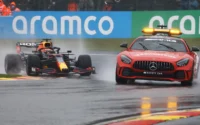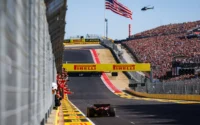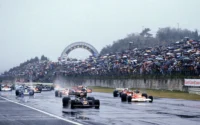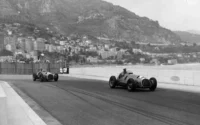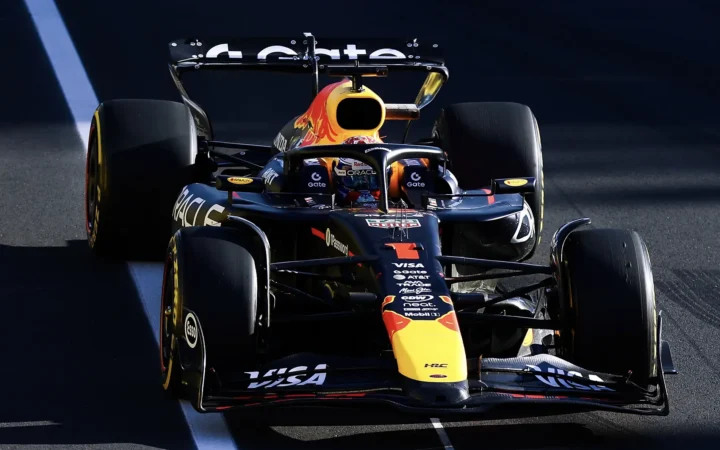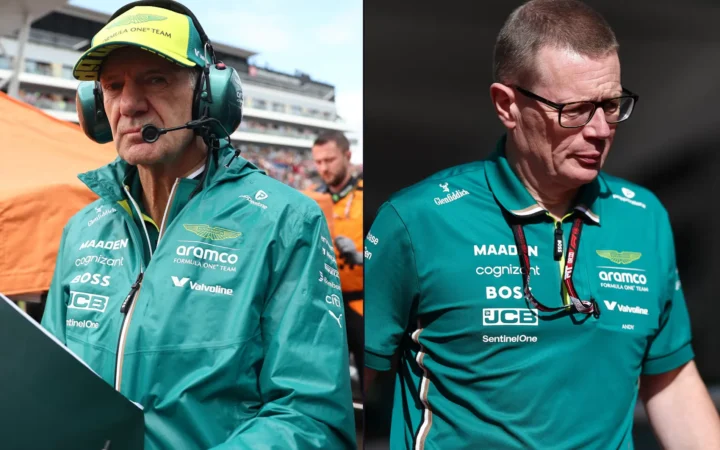Formula 1 isn’t designed for comeback miracles. In a sport where qualifying pace, track position, and strategy are everything, dropping to the back of the field is usually the end of any podium hopes, let alone the top step. But every so often, through a mix of chaos, rain, brilliance, and sometimes controversy, a few drivers have done the impossible.
What To Know?
- David Coulthard – Australia 2003: Recovered from last (after an early tyre gamble) in mixed conditions to claim McLaren’s only win of the year.
- Giancarlo Fisichella – Brazil 2003: Dropped to last mid-race after an early pit stop strategy, then climbed through a wet-weather attrition fest to take the win — officially awarded six days after the red flag.
- Fernando Alonso – Singapore 2008: Dropped to last after an early stop, then surged to victory following a now-infamous team-ordered crash that triggered the perfect safety car. The win stands despite the scandal.
- Jenson Button – Australia 2010: Dropped to 19th after a first-lap incident and bold early switch to slicks. Used superior pace and strategy to win in just his second race for McLaren.
- Jenson Button – Canada 2011: One of the greatest F1 comebacks ever — six pit stops, a drive-through penalty, two collisions, a red flag, and a last-lap pass on Vettel after running 21st.
- Sergio Pérez – Sakhir 2020: Spun to the back on lap 1 after contact with Leclerc, then charged from last to first with a mix of tire strategy and fearless overtaking. Claimed his first F1 win — and Racing Point’s last — in a flawless recovery drive.
We dive into every instance where a driver has fought from last place during a race to take victory. From David Coulthard’s cunning tyre switch in Melbourne to Jenson Button’s all-time classic in Montreal.
Has anyone won from 20th in F1?
Yes — though it’s a rare feat, a handful of drivers have pulled off astonishing last-to-first victories in Formula 1 history, after dropping to last during the race. David Coulthard in Australia 2003, Giancarlo Fisichella in Brazil 2003, Fernando Alonso at the infamous Singapore 2008 GP, and Jenson Button in Australia 2010, and then again in Canada 2011, and Sergio Perez in Bahrain 2020 .
Australia 2003: David Coulthard
Last Place: 20th on Laps 2–3
The 2003 season opener in Melbourne was already a wildcard — the debut of F1’s much-maligned one-shot qualifying format had jumbled the grid, and McLaren’s weekend looked like a write-off. David Coulthard qualified a dismal 11th, team-mate Kimi Räikkönen even worse in 15th, after both botched their single-lap flyers. But Sunday’s chaotic, damp-to-dry conditions flipped the script — and Coulthard played it to perfection.
As Räikkönen audaciously bolted for slicks at the end of the formation lap, Coulthard followed suit a lap later, committing early to dry tyres just as the Albert Park Circuit began to evolve. The decision briefly dropped him to dead last (20th), but it would prove the race-defining call. While others hesitated or pitted too late, Coulthard was already in the groove with tyres up to temperature, climbing back into contention as the race reset following an early safety car triggered by Rubens Barrichello and Ralph Firman tangling.
By lap 11, Coulthard was already seventh — and from there, it was all about keeping his nose clean on a day when few others could. Räikkönen earned himself a pitlane speeding penalty, Michael Schumacher’s bargeboard battle scars forced an extra stop, and Juan Pablo Montoya, under mounting pressure from Coulthard, spun away the lead with just 11 laps to go.
In the midst of it all, Coulthard stayed calm, precise, and opportunistic. While McLaren’s radical MP4-18 never saw a green flag that year, Coulthard’s win in the faithful MP4-17D would be as his final Formula 1 victory.
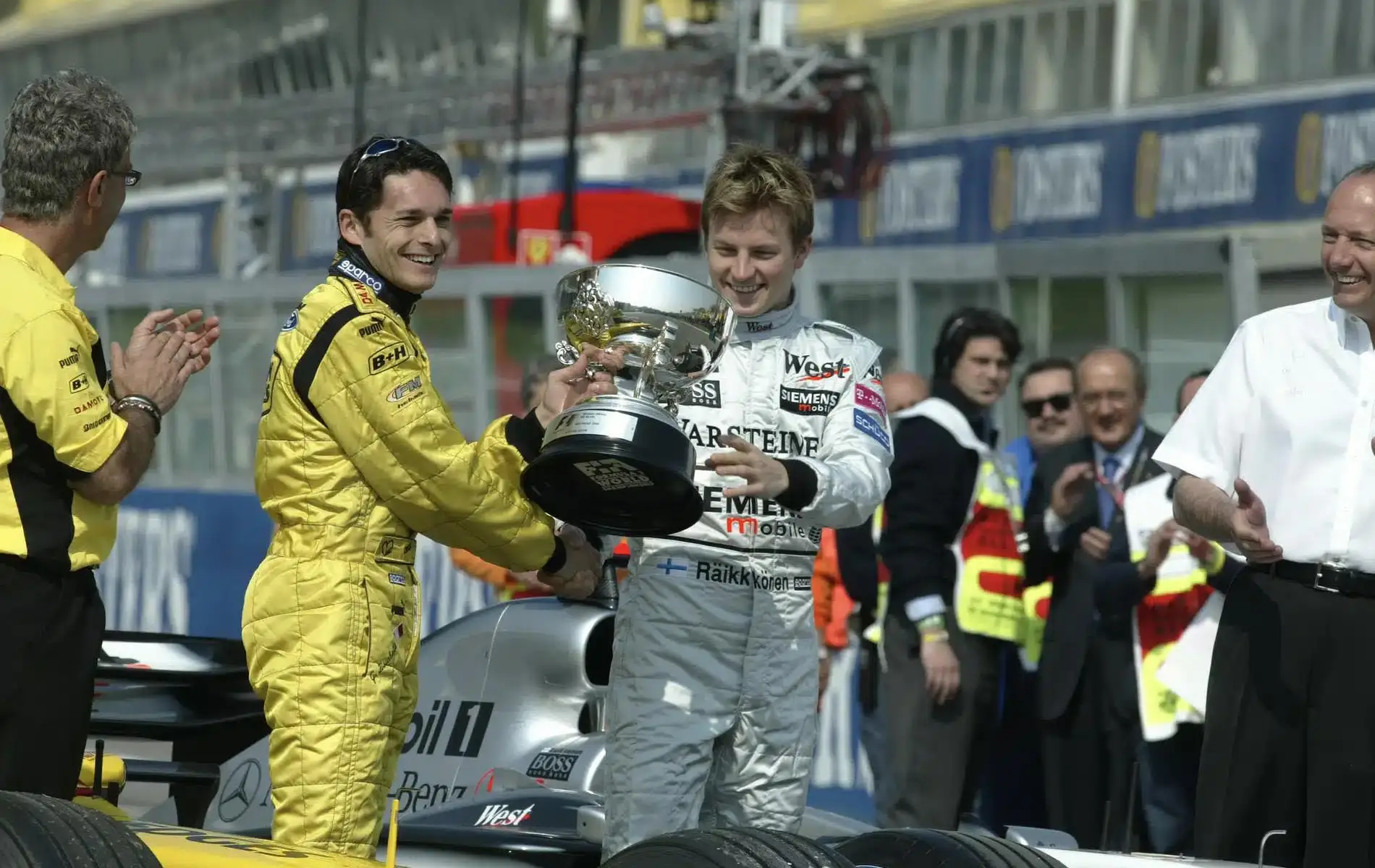
Brazil 2003: Giancarlo Fisichella
Last Place: 16th on Laps 18–19
The 2003 Brazilian Grand Prix was pure Formula 1 bedlam — a sodden, safety car-riddled race that turned into one of the most bizarre wins in modern F1 history. And at the heart of it all was Giancarlo Fisichella, driving for the underdog Jordan team in a race that flipped conventional wisdom — and the result sheet — on its head.
Early on, Fisichella was sceptical when the Jordan pit wall, guided by then-technical director Gary Anderson, called him in for fuel during a safety car. He was running eighth and reluctant to surrender track position, but the strategy was genius in disguise. By brim-filling the tank, Jordan aimed to keep Fisi circulating long enough to meet the crucial 75% race distance threshold — the point at which a red flag would count as a full race.
Formula One History Recommends
Soon after rejoining, Fisichella was shuffled to the back — dead last on laps 18 and 19 — thanks to a chain reaction crash triggered by his team-mate Ralph Firman’s suspension failure. But in the treacherous, rain-soaked conditions, Fisichella was sublime. He stayed on track while names like Montoya, Schumacher, and others were spinning or crashing out, picking his way up the order.
By lap 54, he had charged into second — and just as the race reached its peak of unpredictability, he slipped past race leader Räikkönen. Moments later, disaster struck: Mark Webber lost control of his Jaguar on the front straight, scattering debris everywhere. Fernando Alonso, unsighted, plowed into the wreckage. Red flag. Race stopped.
Initially, chaos continued in the stewards’ room. The win was provisionally awarded to Räikkönen based on countback rules, but after six days of review and recalculation, the FIA confirmed what the stopwatch already showed — Fisichella had completed lap 54 and was the rightful winner. It was his first-ever F1 victory, Jordan’s last, and one of the wildest “last-to-first” stories the sport has witnessed.
Singapore 2008: Fernando Alonso
Last Place: 20th on Laps 13–14
Formula 1’s first-ever night race delivered plenty of spectacle — and one of its most controversial plot twists. At the centre of it was Fernando Alonso, who went from the back of the grid to the top step of the podium in a race that, at the time, looked like a masterstroke of opportunism. Later, it would become known simply as Crashgate.
After qualifying only 15th due to a fuel pressure issue, Alonso rolled the dice on a short first stint, pitting just 12 laps into the race. That left him last — P20 on lap 13, P19 on lap 14 — seemingly out of contention on a tight, unforgiving street circuit where overtaking is notoriously difficult.
Then came the incident that changed everything: Nelson Piquet Jr., Alonso’s Renault team-mate, spun hard into the wall at Turn 17. The resulting safety car sent the field into strategic disarray. Because Alonso had already pitted, he leapfrogged much of the pack as front-runners scrambled into the pit lane, some penalised by the timing of the closed pit window.
Alonso surged to fifth almost instantly. By lap 34, when the final one-stoppers in front of him peeled off, he inherited the lead. With a healthy margin, he made his second stop without losing track position and cruised to what looked like an improbably brilliant win.
But F1’s narrative turned darker a year later. Piquet revealed that his crash wasn’t a mistake — it was orchestrated. The Renault team had ordered the spin to trigger a safety car at the exact moment to benefit Alonso’s strategy. The fallout was seismic: team boss Flavio Briatore and Pat Symonds were banned (later overturned on appeal), and Renault’s team ownership soon ended.
Despite the scandal, the win still stands in the record books. Officially, it remains Alonso’s most infamous comeback drive — a last-to-first that continues to raise questions today.
Australia 2010: Jenson Button
Last Place: 19th on Laps 6–7
If there’s one thing Jenson Button mastered in his F1 career, it was reading a drying track better than anyone else. And in the 2010 Australian Grand Prix, that sixth sense delivered his first win in McLaren colours — even after an early drop to the back of the field.
Starting fourth on the grid after a solid Saturday, Button’s race took a hit almost immediately. At Turn 1, Fernando Alonso was spun around in a first-corner shuffle, clipping Button in the process and forcing the reigning world champion wide. That skirmish shuffled him down the order, and by lap 6, Button was P19 — dead last.
But here’s where Button’s genius kicked in. With the track beginning to dry after a damp start, Button overruled his pit wall and dived in for slicks on lap 6 — the earliest of anyone. It looked premature when he slid off twice on his out lap, still struggling for grip. But within a couple of laps, his gamble paid off: the circuit came to him, and he started carving through the field as others belatedly made the same switch.
By lap 9, he’d vaulted from last to second. When race leader Sebastian Vettel retired on lap 25 with a front-left brake failure, the lead fell into Button’s hands — and he never let it go.
Australia 2010 cemented Button’s reputation as a maestro in changeable conditions. And it wouldn’t be the last time he turned early adversity into an unlikely victory.
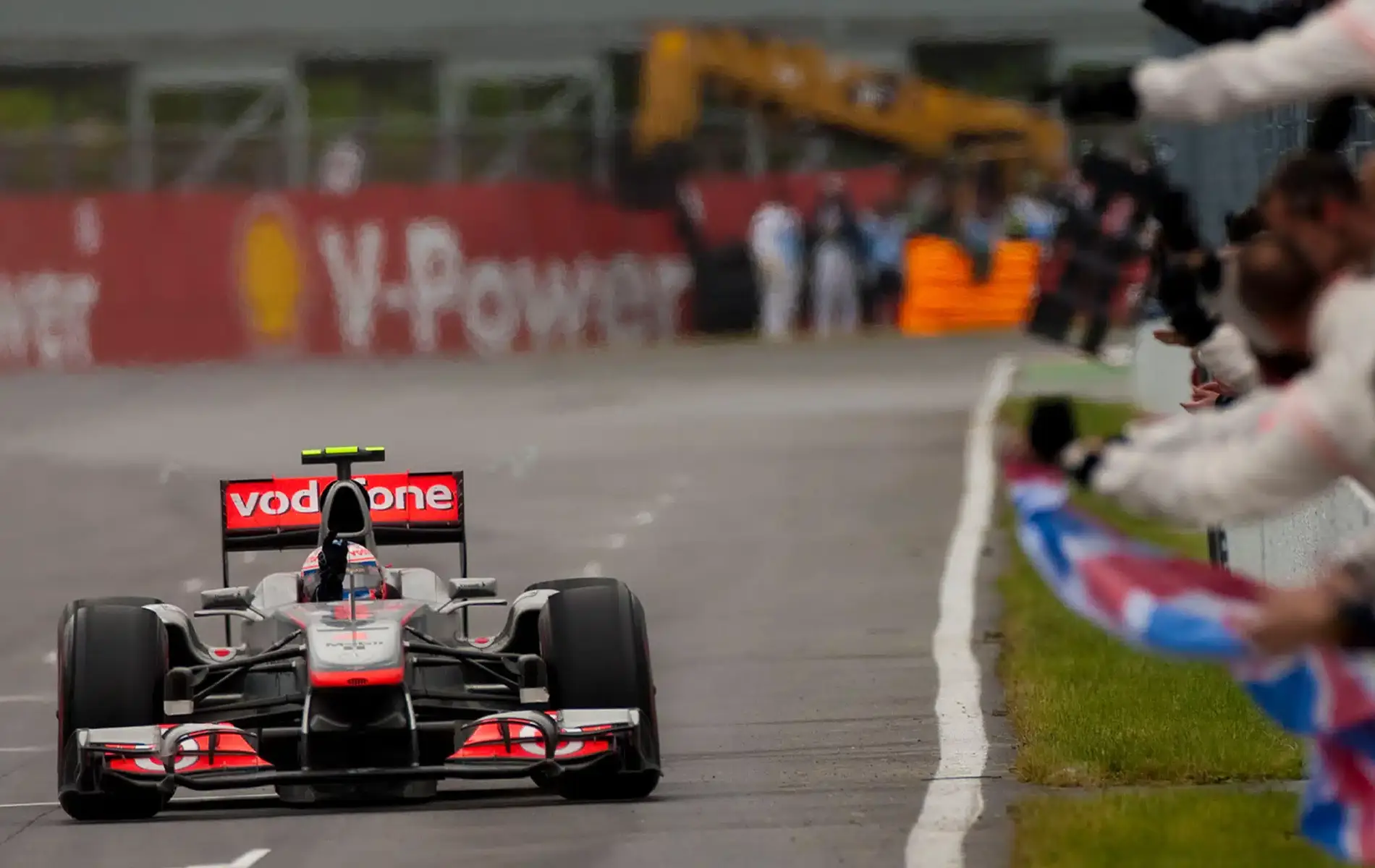
Canada 2011: Jenson Button
Last Place: 21st on Laps 37–40
In a career full of strategic masterclasses and rain-soaked heroics, this was Jenson Button’s magnum opus. The 2011 Canadian Grand Prix wasn’t just a win from last — it was a cinematic epic played out across six pit stops, five hours, and one unforgettable final lap.
It started messily. Button muscled past team-mate Lewis Hamilton at Turn 1, only to run wide a few corners later. As Hamilton tried to re-pass on the front straight, Button unintentionally squeezed him into the pit wall, ending Hamilton’s race and triggering an early safety car. Button pitted for intermediates but then got caught for speeding in the pit lane — serving a drive-through that dropped him to 15th.
Then the rain really came down.
After a two-hour red flag stoppage for monsoon conditions, Button restarted in ninth but immediately pitted for fresh inters. One lap later, chaos struck again: trying to dive past Fernando Alonso into Turn 3, Button clipped the Ferrari. Alonso was out, Button had a puncture — and this time, he was dead last. P21.
What followed was a relentless, inch-perfect comeback. Button timed his switch to slicks better than the frontrunners, carving through the pack on the drying line as others tiptoed through damp patches. By the time the next safety car came out — this time for Nick Heidfeld’s airborne front wing — Button had fought his way to fourth.
When racing resumed, he made light work of Webber and Schumacher, both struggling for grip off the ideal line. That left just Sebastian Vettel ahead, seemingly unshakable — until the final lap. Under pressure, Vettel dipped a wheel onto the damp track and half-spun. Button didn’t hesitate, sweeping into the lead with just corners to go.
Six pit stops. One penalty. Two collisions. A red flag. A last-to-first charge. And a final-lap pass for the win. Button’s 2011 Canada victory wasn’t just the greatest comeback of his career — it might be the greatest comeback in F1 history.
Sakhir 2020: Sergio Pérez
Last Place: 18th on Laps 1–6
Sergio Pérez’s maiden Formula 1 victory at the 2020 Sakhir Grand Prix wasn’t just a career-defining moment — it was one of the rarest feats in the sport: a win from last place.
The race had barely started when chaos struck. Pérez was clipped by Charles Leclerc at Turn 4 on the opening lap, spinning his Racing Point and sending him to the back of the field. He pitted immediately under the safety car, switching to mediums and effectively resetting his strategy — but rejoined in 18th and last, a position he held until lap 6.
From there, he delivered a comeback drive. While strategy played its part, Pérez’s charge wasn’t built on luck alone — it was built on overtakes. He methodically carved through the field, picking off midfield rivals one by one.
Even before Mercedes fumbled a double-stack pit stop for George Russell and Valtteri Bottas, Pérez was firmly in podium contention. Once the race unravelled for the Silver Arrows, he was in the perfect position to capitalise — taking the lead and controlling the final stint with a veteran’s composure.
It was the sixth recorded time in F1 history that a driver had gone from last to first during a race — and perhaps the most emotionally charged, the end of a long road to victory for a driver whose F1 future was, at that moment, uncertain. One that possibly secured his future with Red Bull Racing.
Seen in:

